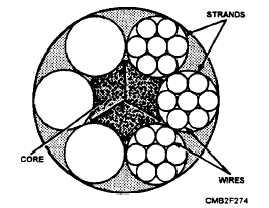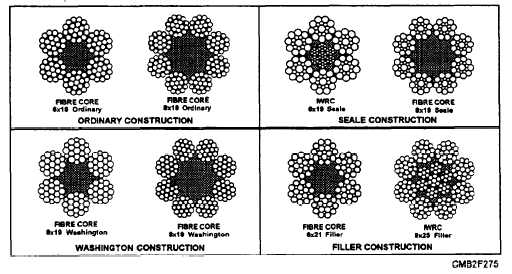WIRE ROPE
Many of the movable components on cranes and attachments are moved by wire rope. Wire rope is a complex machine, composed of a number of precise moving parts. The moving parts of wire rope are designed and manufactured to bear a definite relationship to one another to have the necessary flexibility during operation.
Wire rope may be manufactured by either of two methods. If the strands, or wires, are shaped to conform to the curvature of the finished rope before laying up, the rope is termed PREFORMED WIRE ROPE. If they are not shaped before fabrication, the wire rope is termed NON-PREFORMED WIRE ROPE. The most common type of manufactured wire rope is preformed. When cut, the wire rope tends not to unlay and is more flexible than non-preformed wire rope. With non- preformed wire rope, twisting produces a stress in the wires; therefore, when it is cut or broken, the stress causes the strands to unlay.

Figure 6-33. - Composition of wire rope.
CAUTION
When the wire is cut or broken, the almost instantaneous unlaying of the wire or strands of the non-preformed wire rope can cause serious injury. This situation is apt to occur especially to someone who is careless or not familiar with this characteristic of the rope.
Composition of Wire Rope
Wire rope is composed of three parts - wires, strands, and core (fig. 6-33). A predetermined number of wires of the same or different size are fabricated in a uniform arrangement of definite lay to form a strand. The required number of strands are then laid together symmetrically around the core to form the wire rope.
WIRE. - The basic component of the wire rope is the wire. The wire may be made of steel, iron, or other metal in various sizes. The number of wires to a strand varies, depending on the purpose for which the wire rope is intended. The number of strands per rope and the number of wire per strand designate wire rope. Thus a 1/2-inch 6 x 19 rope has six strands with nineteen wires per strand. It has the same outside diameter as a 1/2-inch 6 x 37 rope that has six strands with thirty-seven wires (of a smaller size) per strand.
STRAND. - The design arrangement of a strand is called the construction. The wires in the strand may be all the same size or a mixture of sizes. The most common strand constructions are Ordinary, Seale, Warrington, and Filler (fig. 6-34) as follows: ORDINARY construction wires are all the same size.

Figure 6-34. - Common strand construction.
Continue Reading